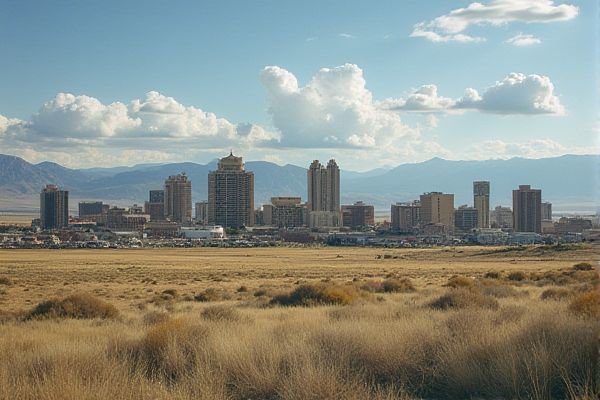
Weather and climate in Wyoming: Cold, snowy winters. Dry, warm summers. Semi-arid climate. Frequent strong winds. Temperature fluctuations. Low humidity levels. Thunderstorm potential. Occasional hailstorms. Prone to wildfires. High-altitude weather impacts.
Cold, snowy winters.
Wyoming experiences cold and snowy winters, characterized by rapid and frequent changes between mild and cold spells, with up to 10 cold waves per winter, though many are not accompanied by significant snow. Snow falls frequently from November through May, with total annual snowfall varying greatly by elevation, from around 15-20 inches in the Big Horn Basin to over 200 inches in the higher mountain ranges. To learn more about the diverse climates found throughout the state, you can visit the Wyoming Climate Office, which provides detailed information on weather patterns and climate history.
Dry, warm summers.
Wyoming's summers are typically warm to hot, with daytime temperatures averaging around 85°F (29°C). These conditions are characterized by dry and windy weather, especially in the lower lying areas, which receive very little rainfall, usually about five inches (127mm) annually. For more detailed information, you can visit the Wyoming Climate page.
Semi-arid climate.
Wyoming's climate is semi-arid, characterized by dry and windy conditions, with lower lying areas receiving as little as 5 inches of rain annually, while mountainous regions can receive over 60 inches. The state experiences warm to hot summers and cold winters with heavy snowfall, especially in the mountains, and has significant temperature extremes due to its high elevation and varied topography. For more information about the climate in this region, visit the Wyoming Climate Report.
Frequent strong winds.
Wyoming is characterized by frequent strong winds, particularly during winter, with wind speeds often reaching 30 to 40 mph and gusts up to 50 or 60 mph. The prevailing wind directions vary from west-southwest to northwest, influenced by the state's terrain, including the Rocky Mountains, and result in significant wind pressure on structures and notable impacts on local weather patterns and daily life. For a comprehensive understanding of these climatic conditions, you can explore more details on the Wyoming State Climate Office website which provides valuable insights into the wind dynamics affecting the region.
Temperature fluctuations.
Wyoming has experienced significant temperature fluctuations, with a statewide annual mean temperature increase of 2.2 degrees Fahrenheit since 1920. Winters are warming at an alarming pace with a 2.8 degrees Fahrenheit increase, and spring temperatures have risen by 2.9 degrees Fahrenheit. This warming leads to earlier and accelerated snow melt, increased likelihood of springtime flooding, and greater evaporation. For more insights on these changes and their potential impacts on both the environment and the economy, you can visit the Wyoming Climate Data article.
Low humidity levels.
Wyoming is characterized by low humidity levels, particularly during the summer when daytime humidity can drop to 25-30% and occasionally as low as 5-10%. Nighttime humidity rises to 65-75%, resulting in a significant diurnal variation, and the overall low relative humidity contributes to high evaporation rates and comfortable summer weather. For more detailed information, please visit the Climate Atlas of Wyoming.
Thunderstorm potential.
Wyoming experiences frequent thunderstorms, particularly in the summer months, with the eastern plains having more than three times the cloud-to-ground lightning strikes as the western half of the state. The frequency of thunderstorms varies, with about 30 days in the western border and up to 50 days in the northeast and southeast corners, and July is the month with the most thunderstorms, except in the extreme southwest where August is more active. For more detailed information on these weather patterns, you can explore the Wyoming Severe Weather resource.
Occasional hailstorms.
Hailstorms in Wyoming are the most destructive type of local storm, causing significant damage to crops and property each year, particularly in open rangeland and crop-producing areas. The eastern part of the state is especially prone to these events. For more information about the impact of these storms, you can visit the Wyoming Climate website, which provides detailed insights into local weather patterns and their effects on the region.
Prone to wildfires.
Wyoming is prone to wildfires due to factors such as dry weather conditions, high temperatures, low humidity, and strong winds, particularly during the dry months of July and August. Additionally, the state's forests, especially those with dense "doghair" forests and trees infested by pests like pine bark beetles, provide ample fuel for wildfires. For more detailed information on these risk factors, visit the official website of Teton County, Wyoming, which provides insights into the challenges posed by such environmental conditions.
High-altitude weather impacts.
In Wyoming, high-altitude areas experience significant climate and weather impacts, including temperatures that rarely exceed 100°F above 6,000 feet, rapid drops in average temperatures with increasing elevation (5.5°F per 1,000 feet), and frequent cold waves that can severely reduce visibility due to blowing snow. High elevations also see substantial snowfall, with some areas receiving over 200 inches annually, and are particularly susceptible to warming trends, leading to earlier and accelerated snowmelt. For more detailed information on these climatic conditions, please visit the Wyoming Climate Atlas which provides an extensive overview of temperature patterns across the state.
